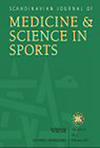Concurrent Repetitions Overestimate Hamstring:Quadriceps Ratios at Extended Knee Joint Positions: Implications for Clinical Practice
IF 3.5
2区 医学
Q1 SPORT SCIENCES
引用次数: 0
Abstract
Most measurements of isokinetic hamstring:quadriceps (H:Q) strength ratios are conducted using concurrent repetitions, whereby active knee extension is immediately followed by active knee flexion. To reduce the influence of the stretch‐shortening cycle and limit axis misalignment, isolated repetitions have been recommended, whereby extension and flexion are completed separately. To inform screening protocols, this study examined the effect of concurrent and isolated trials on discrete and angle‐specific H:Q ratios. Fifteen males (age: 27 ± 4 years; height: 184 ± 9 cm; body mass: 80 ± 9 kg) performed isokinetic tests of the knee flexors and extensors (60°/s) using concurrent and isolated trials while sagittal kinematics were captured (100 Hz). Statistical parametric mapping enabled the effects of protocol type (concurrent vs. isolated) and axis misalignment (uncorrected vs. corrected) to be compared. Uncorrected data resulted in an underestimation of discrete conventional (−10.17%,同时重复高估腿筋:股四头肌在膝关节伸展位置的比率:对临床实践的影响
大多数等速腘绳肌:股四头肌(H:Q)力量比的测量都是通过同步重复进行的,即主动的膝关节伸展紧接着是主动的膝关节屈曲。为了减少拉伸-缩短周期的影响和限制轴错位,建议单独重复,即伸展和屈曲分开完成。为了为筛选方案提供信息,本研究检查了并发试验和孤立试验对离散和角度特异性H:Q比的影响。男性15名,年龄27±4岁;高度:184±9cm;体重:80±9 kg)对膝关节屈肌和伸肌(60°/s)进行等速运动测试,采用并发和孤立试验,同时捕获矢状位运动学(100 Hz)。统计参数映射使协议类型(并发vs隔离)和轴不对齐(未校正vs校正)的效果得以比较。未校正的数据导致离散常规(- 10.17%,p <;0.001)和功能性(- 9.21%,p <;0.05)比率,所有角度特定比率(p <;0.001)。使用并发重复导致传统的H:Q比显著高估(+7.41%,p <;0.05),差异在较大的膝关节屈曲(24°-45°)时最为普遍,p <;0.05)膝关节位置。测力计用户应该意识到,同时重复会增加“假阴性”伤害风险分类的可能性。然而,与从孤立重复中获得的校正数据相比,使用从并发重复中获得的未校正数据的通常做法不会导致离散或角度特定的H:Q比的显着差异。
本文章由计算机程序翻译,如有差异,请以英文原文为准。
求助全文
约1分钟内获得全文
求助全文
来源期刊
CiteScore
7.90
自引率
4.90%
发文量
162
审稿时长
3 months
期刊介绍:
The Scandinavian Journal of Medicine & Science in Sports is a multidisciplinary journal published 12 times per year under the auspices of the Scandinavian Foundation of Medicine and Science in Sports.
It aims to publish high quality and impactful articles in the fields of orthopaedics, rehabilitation and sports medicine, exercise physiology and biochemistry, biomechanics and motor control, health and disease relating to sport, exercise and physical activity, as well as on the social and behavioural aspects of sport and exercise.

 求助内容:
求助内容: 应助结果提醒方式:
应助结果提醒方式:


